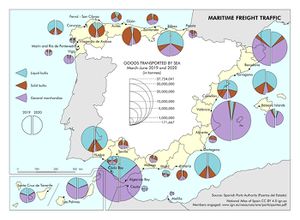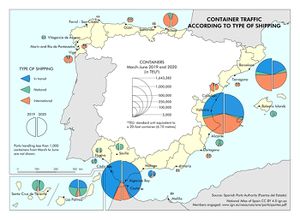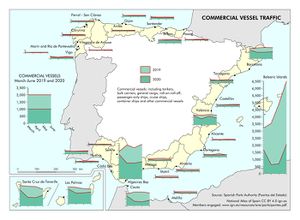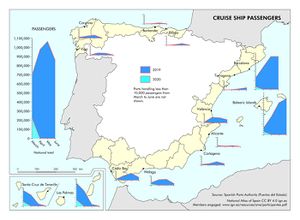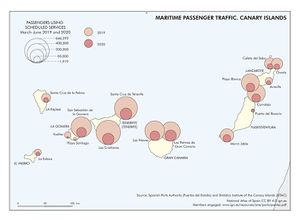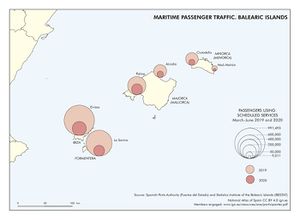Sea transport
The COVID-19 pandemic in Spain. First wave: from the first cases to the end of June 2020
Monographs from the National Atlas of Spain.
Thematic structure > Social, economic and environmental effects > Mobility > Sea transport
The COVID-19 pandemic also had negative effects on sea transport and affected passenger services and, above all, cruise ship traffic. 80% of international freight, including energy commodities, is transported by sea. In the first quarter of 2020, maritime activity registered a year-on-year fall of 6.8%. In the second quarter of the same year, the drop had raised to 27% (The Great Reset, 2021). Decline in passenger and freight transport was detected in 70% of the exclusive economic zones of 124 countries, and was particularly notable in the Western Mediterranean (March et al., 2021).
The amount of goods transported by sea in Spain decreased by 14.4%, from 188.7 million tonnes in 2019 to 161.4 million tonnes in 2020. May 2020 was the worst affected month. Ports, both nationally and internationally, tend to specialise in different types of cargo, which means they were affected by the pandemic in different ways. For example, 20% of the total amount of goods shipped from commercial ports in Spain is channelled through Algeciras –at the strait of Gibraltar–, and 70% of those goods are general merchandise. Most of the goods handled at the ports of València, which deals with 15% of the freight loaded and unloaded in Spain, and Barcelona, which handles 10%, also fall into this category. These more generalist ports see the most traffic, whilst the ports of Cartagena, Huelva, Bilbao and Tarragona are more specialised, being 60% - 70% of their cargo liquid bulk. Each of these ports handles around 7% of the total port flows in Spain. The ports of València and Algeciras each account for 30% of the container shipping flows, followed by Barcelona, with almost 20%. Algeciras handles the most significant volume of cargo in transit, at 86%, followed by València and Barcelona, which handle nearly 60% of containers in transit and around 40% of international traffic.
The amount of goods transported on container ships fell by 14% in 2020, which is a similar drop to the one observed in traditional cargo. The 5,980,000 TEUs (twenty-foot equivalent units) handled in 2019 were reduced to 5,130,000 for the same period in 2020. The month of May registered the most significant decrease in cargo (- 20%). Taken as a whole, over 50% of the containers reaching Spanish ports are in transit and over 30% come from abroad; little more than 10% of the cargo is national. This small percentage of national freight registered the sharpest drops in 2020, falling by over 20%.
Shipping traffic fell by 47% during the reference period, from 56,579 commercial vessels in 2019 to 30,113 in 2020. Whilst drops were observed on all types of vessels, they were more acute for passenger ships, which continue to lag behind in recovering pre-pandemic figures. These data are consistent with the patterns in shipping traffic observed throughout the Western Mediterranean, where a high proportion of maritime traffic is bred by tourism (March et al., 2021).
Cruise ship traffic has experienced huge growth in recent years. However, it was brought to an abrupt and complete halt during the first half of 2020. This stop entailed a 94% drop in passengers, with only 217,000 transported in 2020 compared to 3,609,857 in 2019. Figures on passengers plummeted by 69% in March and 100% in April, May and June 2020. Barcelona and the ports in the Balearic Islands (Illes Balears) are the main cruise ports in the Spanish Mediterranean, and Barcelona receives more cruise ships than any other port in the Mediterranean Sea. In 2019, 30.5% of cruise passengers in Spain transited through Barcelona. The ports in the Balearic Islands (Illes Balears) handled 24% of passengers, with Palma (Majorca/Mallorca) accounting for the largest part of that share. The Atlantic Ocean ports of Las Palmas de Gran Canaria and Santa Cruz de Tenerife in the Canary Islands (Canarias), whose operations are less seasonal, accounted for 12.5% and 9% of that traffic. More than three-quarters of cruise ship passengers in Spain reached one of these four ports. In 2020, however, the Atlantic ports saw more traffic, with 33% of the traffic passing through Las Palmas de Gran Canaria and 23% through Santa Cruz de Tenerife. This halt was widespread in the Mediterranean, which, along with the Caribbean, is one of the most popular cruise destinations in the world. The ports of Barcelona and Palma (Majorca/Mallorca) handled less than 14% of their usual amount of passengers, and traffic at other Spanish ports was insignificant
The scheduled maritime passenger services registered a year-on-year drop in passenger figures of over 80% from 2019 to 2020, with the minimum recorded in April: -96.5% (Martos, 2020). The effect on passengers in the ports of the Balearic Islands (Illes Balears) and Canary Islands (Canarias) deserves particular attention, as the lack of alternative road and rail connections in these archipelagos breeds continuous and vital maritime flows. Furthermore, whilst every island in the Canary Islands (Canarias) has an airport, Formentera in the Balearic Islands (Illes Balears) is fully dependent on maritime connections.
In the Canary Islands (Canarias), the ports of Santa Cruz and Los Cristianos in Teneriffe (Tenerife) handled the majority of scheduled traffic passengers, accounting for almost 15% of the total trips. They were followed by the ports of Las Palmas de Gran Canaria, with 14%, and San Sebastián de la Gomera and Las Nieves, with 10% each. The Canary Islands (Canarias) followed the same downward pattern as other Spanish ports, with the passenger traffic for March, April, May and June 2020 falling by 74.8% compared to 2019 (3,934,568 passengers in 2019 and 992,211 in 2020). In the Balearic Islands (Illes Balears), the annual traffic fell from 7,250,185 passengers in 2019 to 3,907,329 in 2020, i.e. a decrease of 46%. All the ports were affected equally, except for La Savina (Formentera), where the drop was even more significant. During the reference period, the amount of passengers fell by 77% in the Balearic Islands (Illes Balears) –slightly more than in the Canary Islands (Canarias)–, with only 563,739 passengers in 2020 compared to 2,467,175 passengers in 2019. Formentera registered the most significant drop, at 82%. In 2019, the traffic passing through the ports of Ibiza (Eivissa) and Formentera accounted for 70% of the total traffic in the Balearic Islands (Illes Balears), yet dropped to 61% in 2020. Formentera, which has no air connections, breeds daily and continuous maritime traffic between La Savina and the port of Ibiza (Eivissa) for work, shopping, leisure, etc. In 2019 and 2020, 15% and 23% of passengers embarked and disembarked in the port of Palma (Majorca/Mallorca). In terms of passenger percentages, Palma is followed by Alcúdia and Ciutadella, which handle 7% of passengers in the islands on the line that connects Majorca (Mallorca) and Minorca (Menorca).
Co-authorship of the text in Spanish: Maurici Ruiz Pérez and Joana Maria Seguí Pons. See the list of members engaged
- MARCH, D. et al. (2021): «Tracking the global reduction of marine traffic during the COVID-19 pandemic», Nature Communications 12, 2415. Available in: https://doi.org/10.1038/s41467-021-22423-6
You can download the complete publication The COVID-19 pandemic in Spain. First wave: from the first cases to the end of June 2020 in Libros Digitales del ANE site.
